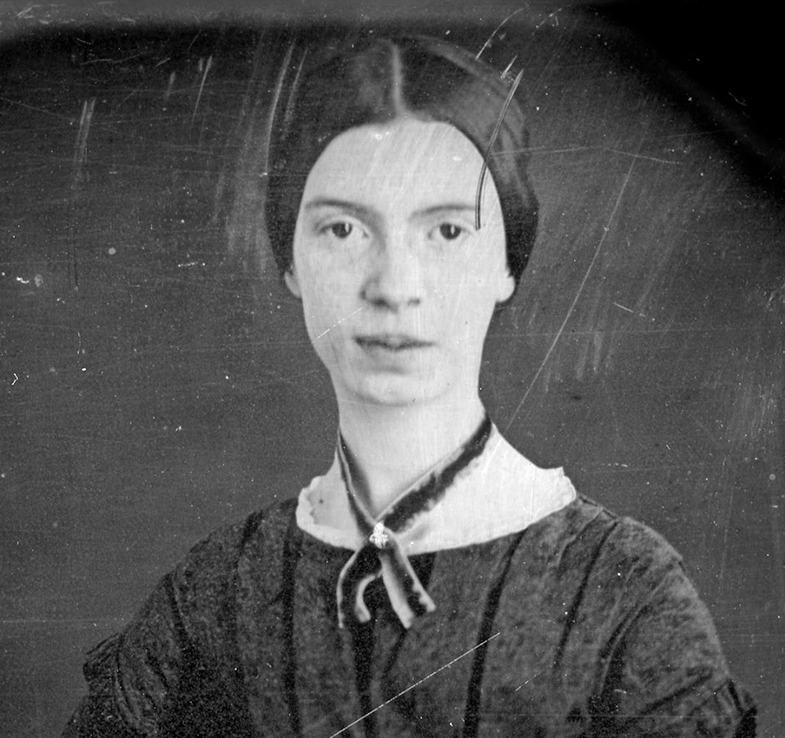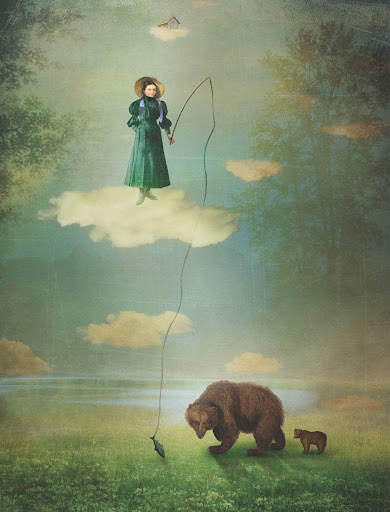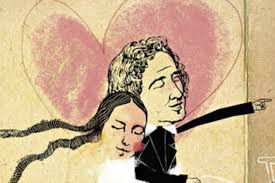Art & Agoraphobia
Sunday Life
July 6, 2007
It may have been Emily Dickinson who struck the first spark. Certainly her story fascinated me. The eccentric spinster who never left her home and never allowed visitors to see her. Dressed always in white, in the fashions of her youth, she sat in the darkness on the stairs, listening to the conversation in the sitting room. If she liked what was said, she would send in a glass of wine and a poem she had dashed off just that moment. After she died, her sister found nearly two thousand poems stuffed into her bureau, in all stages of composition. For the next sixty years, Emily’s friends and family struggled to find an audience for her poetry, of which only six had ever been published. Now Emily Dickinson is considered one of America’s finest poets.
I first read about Emily Dickinson in my mid teens, when I too was writing compulsively every day. I was stricken by shyness and an overwhelming sense of my own oddity. Girls my age permed their hair, chatted up boys at the bus-stop and stuck posters of Duran Duran on their walls. I read Wuthering Heights and The Bell-Jar, wrote a poem a day, always had at least one novel in progress, and dreamed of winning the Nobel Prize for Literature.
It was not too great a step to imagine myself an eccentric spinster, weaving webs of words in seclusion, neglected and misunderstood until after my death. I collected such stories. Emily Brontë who would not leave her beloved moors. Elizabeth Barrett who would not leave her bed. Dante Gabriel Rossetti who spent the last five years of his life incarcerated in his decaying mansion with a menagerie of exotic animals. J.D. Salinger, occasionally glimpsed as a blurred shadow in someone’s telescopic lens. Dorothy Parker, who died an impoverished drunk in a hotel room, with only her dog to notice she no longer breathed.
I never intended to write a novel about an agoraphobic artist, though. It was only after I had been writing Sara Sanchez’s story for some time that I realised she was unusually timorous, and it took me quite a while longer to learn she had not left her home in five years.
Sara suffers from such severe panic attacks she cannot get into a car or speak a word to a stranger or go to the shops for milk. She has certain rituals against harm – counting her steps, turning over her pillow three times before going to sleep, compulsive reading of the tarot. She dreams of being an artist like her famous father, but can no longer bear to paint. She is a prisoner of her own terror.
Like 1.8 million other Australians.
Agoraphobia. The term was coined in 1871 by the German psychiatrist Carl Otto Westphal from the Greek, meaning “fear of the marketplace”. Nowadays, it is usually defined as an “overwhelming and incapacitating fear of being away from the seeming safety of home.” It is often called ‘the Greta Garbo Syndrome’ after the legendary actress who holed herself up in her New York apartment for almost fifty years, saying famously ‘I just want to be alone’.
The first recorded instance of the disorder is in 300 BC, when Hippocrates described a man who ‘through bashfulness, suspicion and timorousness, will not be seen abroad … he thinks every man observes him.’
Charles Darwin drew a vivid picture of the symptoms: “the heart beats quickly and violently … the hairs … stand erect and the superficial muscles shiver … the mouth becomes dry … the breathing is laboured … there is a gulping of the throat … (then) all the muscles of the body are relaxed, utter prostration soon follows …’
Darwin knew what he was writing about. Recently, two physicians released a report in ‘The Journal of American Medical Association’, arguing that the mysterious ailment that kept Darwin confined to his home for twenty years – time that he spent writing The Origin Of Species – was in fact panic disorder aggravated by agoraphobia.
Edvard Munch’s 1893 painting ‘The Scream’ expresses even more powerfully the existential terror felt by the agoraphobe. Munch was walking along the road with two friends when “the sun set. The sky became a bloody red. I felt a touch of melancholy. I stood still, leaned on the railing, dead tired. Over the blue-black fjord and city hung blood and tongues of fire. My friends walked on and I stayed behind, trembling with fright. And I felt a great unending scream passing through nature.”
It is normal to be afraid sometimes. The word ‘fear’ comes from the Old English meaning ‘sudden danger’. It is normal to feel anxiety.
It is not normal to be so overcome with terror that one cannot catch a bus to work, or hold a conversation about the weather with an old school friend, or check the letter-box. Some agoraphobics are so stricken with dread they cannot even leave their bed. Elizabeth Barrett may have been one. She was confined to her bed for over five years, writing ‘I did most emphatically abominate and nauseate the going downstairs.’ At last she found the courage to flee her father’s house and elope with Robert Browning. She would remain a recluse to the day of her death, however, just one of numerous Victorian women writers so inflicted.
Christina Rossetti, the younger sister of the Pre-Raphaelite painter Dante Gabriel Rossetti, was a classic example. In her youth she was a clever, witty, lively girl. By her late teens she was stricken by a mysterious illness, characterised by a hammering heart, a feeling of faintness, a sense of suffocation, a horror of having to talk to strangers. She rarely travelled from home, writing: ‘I have so long indulged in stay-at-home habits that a strange morning call has its formidable side.’
At the age of twenty-four, Emily Dickinson wrote ‘I don’t go far from home unless emergency leads me by the hand,’ and a few years later, ‘I do not cross my father’s ground to any House or Town.’
Their contemporary Emily Brontë tried numerous times to leave Haworth and earn her keep as a governess. When she at last returned home after a disastrous trip to Brussels in 1842, she wrote a poem declaring:
“So hopeless is the world without,
The world within I doubly prize;
Thy world where guile and hate and doubt
And cold suspicion never rise.”
She would never leave Haworth Parsonage again.
Agoraphobia is not confined to sexually repressed Victorian spinsters. The actress Kim Basinger recently recorded a documentary about her battle with the disorder, saying: ‘Fear is something I’ve lived with all my life … especially fear of being in public spaces. Fear of fear. Fear that fear would come. Once you have had a panic attack, you never want to go there again.’
The singer Dido suffered her first panic attack in 1995, after being told six people had been stabbed in her audience. That night, in her hotel room, she thought she was suffering a heart attack, a common misapprehension. For the next year the anxiety attacks grew in frequency and intensity until she was unable to leave her flat at all. Writing out her feelings in songs like ‘Slide’ and ‘Honestly OK’ helped, but she still has to fight constantly against anxiety.
Of course, the most infamous recluse of all is J.D. Salinger, author of The Catcher In The Rye. His excessive insistence on privacy is so profound that no-one can say with any assurance why he has locked himself away behind high walls. Is the revulsion he feels for other people a symptom of agoraphobia, or some other dissonance of the soul? Even his daughter Margaret, imprisoned behind those same walls as a child, does not understand. She has consequently had her own struggle with uncontrollable anxiety. When she began her memoir Dream Catcher, she found herself “re-experiencing the nightmare world of a terrorised little girl … I had an overwhelming, disorienting, vertiginous feeling that if I wrote this book, something terrible and evil would happen.’ Later, she describes experiencing “unspeakable postpartum panic attacks.”
Agoraphobia is the most secret of maladies, for by its very nature, sufferers are not seen or heard. Usually, it is a condition that sneaks up slowly and, since agoraphobes usually try and hide their affliction, ashamed and fearful of being labelled mad, friends and family may not notice the gradual narrowing of their world until it is too late. So unknown was this dysfunction that when I wrote about a girl who built herself a prison with her own hands, I had no idea what I was writing about. It is only now that I can name it and describe it and classify it, and find thousands of websites devoted to advice on how to overcome it, or at least, how to try and live with it.
Like many writers, the first sycamore seed of an idea comes to me as a kind of vision. I first saw Sara at the age of seventeen, daydreaming on the long journey down the coast one summer. I saw her standing on a hillside near the sea, her hair blown back by the wind, gilded with the last vivid light of the day, gilded with joy. I scribbled around this image for years, knowing only that for her to reach that apotheosis of gladness she must have travelled a dark and thorny journey first.
And so, in writing Sara’s story, I thrust down a taproot into the richly fed soil of my imagination and found all the stories that had fascinated me as a young woman: van Gogh and his severed ear, Sylvia Plath and her three deaths, an elderly Emily Dickinson lowering down sweets to the village children on a string, Dante Gabriel Rossetti exhuming his dead wife’s body to retrieve the poems he buried with her, Virginia Woolf and her pockets heavy with stones.
For it was clear to me that Sara was some kind of artist. Apocryphal as it may be, I had always felt that the creative artist saw things more clearly, felt things more deeply, suffered more acutely. Perhaps this is because so many other writers and artists believe so too. William Faulkner wrote: ‘An artist is a creature driven by demons’ while George Santayana said: ‘The soul too has her virginity and must bleed a little before bearing fruit.’
Perhaps it was because I too, like Sylvia Plath, suffer from ‘skinlessness’. To me this has always meant a failure to grow the carapace that protects one’s soul from the pain of feeling too deeply. But with this vulnerability comes a greater sensitivity to beauty, a deeper insight into human frailty and, I believe, a greater capacity for joy.
While researching agoraphobia on the net, I came across a lecture given by an Australian doctor to a psychotherapy conference in New York in 1977. Dr Claire Weekes, while discussing her successful treatment of agoraphobia, outlined the condition she called ‘sensitization’ in terms that raised goose-pimples on my body.
Dr Weekes wrote: ‘Sensitization is a state where … nerves react to stress with unusual intensity and sometimes with disconcerting swiftness, so that the sensitized person experiences heightened nervous sensations (thumping, banging heart, ‘missed’ heartbeats, attacks of palpitations, giddy ‘spells’, weak ‘spells’, churning stomach and so on) and excessively strong and precipitant emotions of responses. Mild anxiety becomes acute; a sad event seems tragic; a strange sight may be disturbingly eerie; love may be felt so acutely that the mere sight of the hand of a loved one moves a sensitized person to tears; joy may be expressed hysterically. Above all, mild fear or minor shock, even nothing but a sudden blast of cold air, is often felt as flashing, electrifying panic that seems to singe the roots of the sufferer’s hair ...’
The resemblance to the opening lines of Sylvia Plath’s poem ‘The Hanging Man’ is uncanny: ‘By the roots of my hair some god got hold of me. I sizzled in his blue volts like a desert prophet.’ What is even more uncanny is that I used these lines as an epitaph to my novel for quite a few years, even planning to call it ‘The Hanging Man’ at one stage.
So, the question I am being asked all the time now is “have you ever suffered agoraphobia?” And, truthfully, I can say no. But then I have read Emily Dickinson, who advises ‘Tell all the truth but tell it slant.’








